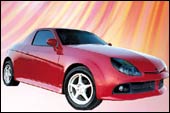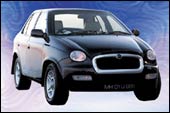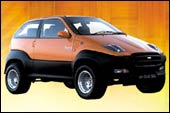 |
| Dilip Chhabria, CEO, DC Design: The man
still pens the initial design for all his work |
At
the Geneva motor Show in March this year, Dilip Chhabria had every
reason to return with a trailor truck-sized complex. His modest
stall was tucked away under the main hall, there were no slick AV
presentations running on a giant screen, and his marketing team
was all of three-Chhabria included. Still, if the 48-year-old Chhabria
wagered Rs 1 crore for real estate at the show, it was because he
knew he had one big thing going for him-the Infidel. A concept car
based on the Toyota mr2 platform, designed to marry the style of
Italian super cars with Chhabria's own vision of a road monster.
The Infidel's radical design created such a
buzz that three of motown's biggest design lords decided to look
up the "rakish" car. One was Bob Lutz, General Motor's
Head of development; another was Chris Bangle, Chief of BMW's design;
and the third, Henrik Fisker, Creative Director at Ford's design
studio in London and Aston Martin's Design Director. Good for Chhabria,
because instead of returning to Mumbai feeling bruised and crushed,
he actually found himself-on a freezing morning three days after
the show-standing outside Ford Motor's new design studio, called
Ingeni, in London. After a long meeting, Fisker made Chhabria a
stunning offer. Would he be interested in designing a prototype
for a new Aston Martin (a Ford subsidiary) model based on the best-selling
db7?
The rest, as they say, is (contemporary) history.
Returning to Mumbai, Chhabria finalised the deal and got down to
work. Less than 110 days later, the db7 prototype was on a ship
bound for the US, where it would be displayed at the hi-profile
North American International Auto Show in Detroit in January 2003.
Says Chhabria: ''As far as the cost-quality equation of car design
is concerned, we have no parallels in the world.''
Global Highway
That's true. As far as pure design skills go,
Chhabria's DC Design-which offers broadly three services: rapid
prototyping, design on demand, and styling-is probably as good as
its global peers. But in terms of costs and sheer availability of
manhours, it is streets ahead.
DC Design can do in $2.5 million what a designer
abroad would charge $10 million-and it has 1 million manhours. Also,
Chhabria boasts of remarkably quick turnarounds. For example, the
db7 prototype went from concept to finish in just three-and-a-half
months. The Infidel that he took to the Geneva show was designed
in three months flat, too. Moreover, prototypes are usually dummies
made of fibre glass. But Chhabria makes them using sheet metal and,
yes, they can be driven as soon as they are finished. Of course,
that's because he only designs the skin, everything else under it
comes from the customer. But the question is, if Chhabria churns
out world-class design sitting in his 65,000 sq ft Mumbai studio,
just how does he do it?
The Man And His Machines
Some of the cars that Chhabria worked wonders
with. |
Zelo
A 2x2 coupe based on the Daewoo Nexia. 17"
wheels and tight overhangs give it a smooth appeal |
 |
|

|
Ikonconcept 2003
Developed jointly with Ford India,
this Ikon car was given a mean roadster look at DC's studio
|
|
Phoenix
You'd never guess this. It's the
plain old Ambassador under a stunning skin that DC gave it
|
 |
 |
Arya
You'd never guess this either. This
snobbish SUV is actually based on the Tata Sierra mechanicals
and floor!
|
|
Ra
A 2x2 stylised mini sport utility
based on the Suzuki Jimny. If you are a sucker for looks,
this will win your heart
|
 |
 |
Infidel
This is the car Chhabria took to
the Geneva Motor Show this year, and that got him the Aston
Martin deal
|
Two reasons: One, the way his team of 450 is
structured and two, the technology that he puts to use. DC Design,
which BT estimates has an annual revenue of Rs 15 crore, has two
broad divisions: designing and prototyping. The former takes care
of styling, designing, and marketing, and the latter takes care
of giving the design a physical shape. All the original lines for
the car are sketched by Chhabria himself ("can't afford to
hire a global designer," he says half-jokingly). This is then
taken up by his core design team of seven, hired mainly from institutes
like Industrial Design Centre, IIT, Mumbai, and the National Institute
of Design, who create a digital model using computer-aided styling.
Then, a 3-d model is developed for the ''look-and-feel'' of it.
Once the customer okays the computer-generated model, the design
is sent for prototype fabrication. The prototype approved, DC's
fabrication unit churns out the required number of copies.
Typically, in design though there are a number
of trade-offs involved, especially among time, cost, and quality.
When a designer tries to speed up a project, either costs go up
or quality suffers. On the other hand, if he spends more time building
quality into his design, time and costs increase. These are issues
at DC Design too, but the company has one major advantage. It is
a relatively small outfit, and that allows the various designers
to work more closely, thereby minimising communication gap and rework.
Says Pankaj Jhunja, head of the design studio: ''There is neither
any repetitive job nor any supervisors in the organisation. Everyone
is his own manager.''
Chhabria may never have gotten to owning his
own design firm had he not battled complacency to try the untested.
After he graduated from the Art Center, he went to work for General
Motors in Detroit. But within a year, he realised that he didn't
want to spend the rest of his life as an anonymous designer. Quitting
gm, he returned to Mumbai in 1981, and joined his family's modest
electrical components business. Soon he shifted focus to auto accessories,
and in just a few years his venture started making so much money
that his father shut his own venture and handed Chhabria the reins.
 |
| The Aston Martin DB7: Coming soon, a
DC version |
Over the next 10 years, he prepared the ground
for his car design venture, investing in equipment and knowhow.
In 1992, Chhabria picked up a Maruti Gypsy and reskinned it. And
one day when he was driving around in Mumbai in it, he was flagged
down by a man who offered to make a spot deal for the vehicle. Chhabria
agreed and sold the Rs 1.73 lakh vehicle for an impressive Rs 5.5
lakh. Thereafter, DC designed cars became his advertisements, and
customers started queuing up.
What followed were a series of traffic-stopping
modification jobs (See The Man and His Machines). Take the Arya,
for example. It's a Tata Sierra, but the skin is completely redone
to give it a snooty suv feel. Or the Phoenix. It's the plain old
Ambassador turned into a trendy sedan. In fact, Chhabria did this
just to prove a point.
That innovative design can transform even the
stodgiest of metal. In the last 10 years, he has customised more
than 470 cars. Some of his celebrity customers include liquor baron
Vijay Mallya, movie stars Shah Rukh Khan and Juhi Chawla, and political
big-wigs such as Bal Thackeray. Says Alan Durante, Executive Director
and President (Automotive), Mahindra & Mahindra: "(Chhabria's)
designs are contemporary, and they are benchmarked against the very
best products in the world."
Still, there are some big gaps in DC Design's
skill sets. For instance, it can't do any engineering work such
as engine tuning. Chhabria says that he is on the lookout for a
suitable partner. But the Aston Martin deal has created a wave of
optimism within the company. Next year, Chhabria plans to take to
the Geneva Auto Show ''an anti-thesis of the Infidel'', which will
be ''monstrous, sweptback, and (in all) a unique sports car''. You
never know what that may lead to.
|

